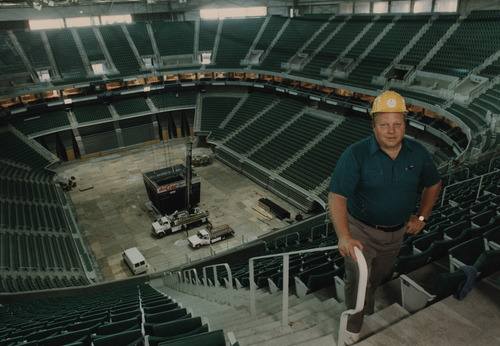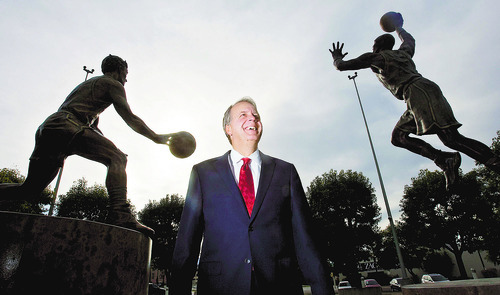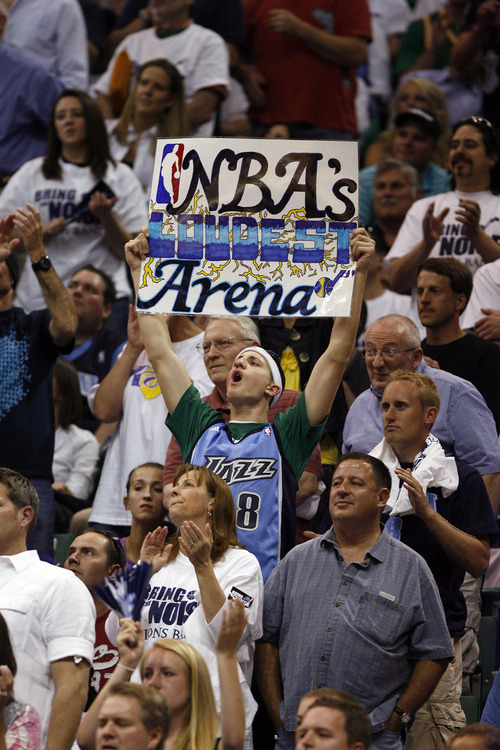This is an archived article that was published on sltrib.com in 2011, and information in the article may be outdated. It is provided only for personal research purposes and may not be reprinted.
Jazz President Randy Rigby has devoted 25 years of his life to the Larry H. Miller Group of Companies. He's outlasted Jerry Sloan, Deron Williams and Miller, whose self-branded multibillion-dollar empire was founded upon automobiles but revolves around professional basketball.
Rigby has watched the Jazz evolve. He worked his way up through the organization while Karl Malone and John Stockton ruled the hardwood and a still-elusive NBA championship was within Utah's grasp. He was behind closed doors during a dramatic 2010-11 season, when the Jazz fractured and fell apart, Sloan resigned and Williams was traded away.
Rigby has also watched the Salt Lake City region change. Once, the Jazz were enough. Now, Real Salt Lake is rising, the University of Utah has grabbed the spotlight in the Pac-12 and Brigham Young is as popular as ever. All while the NBA is fighting a labor war, with owners and players battling for revenue and power, and small-market teams struggling for their existence.
Rigby's seen almost everything during his 25 years with LHM. But his answers to the challenges the Jazz face remain the same: keep evolving, keep changing and, most importantly, keep making money.
"You can't always stay on top of the mountain. That's sports," said Rigby, during an exclusive interview with The Salt Lake Tribune. "But to keep showing that we're relevant … to build loyalty — that's one of the important things that we try to keep doing."
—
Fresh eyes • Loyalty is at the core of the Jazz's continued dominance over Salt Lake's increasingly crowded sports market.
Frank Layden, Miller and Sloan engineered Utah's ascension, which saw the team rack up 16 consecutive winning seasons, 19 playoff appearances and two NBA Finals runs during Sloan's 23-year Hall of Fame tenure.
Patrick Rishe, sports business professor at Webster University in St. Louis, said the unparalleled consistency is invaluable to a small-market franchise in a big-market league. Factor in Salt Lake's geographic isolation and the lack of entertainment options in the region, and the Jazz have come to represent Utah as much as The Church of Jesus Christ of Latter-day Saints does.
"Much like Chicago still benefits from all those [Michael] Jordan years, Utah still benefits from all those Stockton and Malone years," said Rishe, who is also the director of Sportsimpacts, a consulting firm. "[The Jazz are] going to have fans. Even though I'm sure they get frustrated at times — the level of success maybe isn't as consistent as it was during those years — there are always going to be Jazz fans because they got hooked in those days."
Rigby's primary responsibility since he was promoted to team president in 2007 has been to connect the past with the present, while ensuring the Jazz continue to move forward.
He took the job with two goals in mind: Build a stronger bridge to the community by strengthening relationships with corporate and civic leaders; tear down the divide that long separated the different components of LHM's sports-and-entertainment division.
While acknowledging his 25-year run with the organization is still a work in progress, Rigby believes he's doing both.
Key advertisers have been allowed to travel with Jazz players on the team's charter plane. Coaching clinics have been conducted during the lockout for season ticket holders. Sponsors were allowed to watch from a special room as former BYU star Jimmer Fredette participated in a heavily hyped NBA draft workout for Utah. Meanwhile, Rigby made six trips to NBA cities last season, examining how teams such as Phoenix run their game-day operations and maximize their marketing potential.
"I like to get fresh eyes on another NBA team," Rigby said. "There's always something you can learn from another market. … Even get a feel of their city and what it's like, and what is going on so we can better compare it. There's always room for growth."
—
Financial exposure • Despite finishing with a disappointing 39-43 record last season and failing to make the playoffs for the first time in five years, the Jazz continued to expand.
Utah ranked No. 3 in the league in sponsorship dollars and set an all-time organizational record. The franchise trailed only San Antonio in average local television ratings. And the Jazz finished in the top seven in average home attendance for the fifth consecutive year, with nearly 800,000 paying customers entering the franchise-owned building.
TV has been Utah's biggest payday. The organization continues to benefit from an exclusive 12-year deal with DirecTV's ROOT Sports that runs through 2020-21. Seventy-nine regular-season Jazz games were shown in high-definition last season, reaching fans in Utah, Wyoming, Idaho and Montana.
Rigby orchestrated the agreement in 2009. After the ink dried, he was pulled aside by the Millers, who informed him the contract was the largest in LHM history.
"One of the nicest compliments I received from Larry and Greg … there's been some pretty big deals in the Miller organization," Rigby said. "And so I think it was an important shot in the arm for us; it was very significant."
Rigby would not reveal the specific amount of the contract. It is believed to be worth in the range of $200 million to $300 million.
Tim Griggs, ROOT Sports general manager, said the station built its network around the reach of Utah's professional basketball team.
"From our standpoint, the Jazz are the most powerful and popular sports franchise in the region," Griggs said. "They've got tremendous fan support throughout the entire region, and it's allowed us to bring other product into the territory."
But the deal is small-market pennies compared to a reported $3 billion, 20-year contract the Los Angeles Lakers signed this year with Time Warner Cable. Even if revenue sharing improves among teams in the new collective bargaining agreement — it could quadruple compared to the previous deal — Rigby acknowledged there is little the Jazz can do when competing against big-market cities that can swallow Salt Lake whole.
"That's the biggest challenge for us," he said.
—
Still on top • Rigby has become confident running the Jazz and the rest of LHM's interrelated sports-and-entertainment wing. He is outgoing and friendly when greeting season-ticket holders, comfortable and smooth around sponsors.
But the same NBA president who privately wondered in 2007 whether Larry Miller was about to fire him instead of promote him — an inside joke Miller only let Rigby in on via a warm smile — openly acknowledged the hurdles Utah still faces.
Small-market challenges top the list and run deep. But question marks follow everything from how the rebuilding Jazz can remain competitive on the court to what it will take for Utah to pull in a hard-to-predict youth market increasingly drawn to social media and the comforts of home.
The biggest question: "How do we engage the fans?" Rigby said.
Then there are the region's growing giants: Real Salt Lake, the University of Utah and BYU. Unprovoked, Rigby brought up the trio, highlighted their prowess and paid tribute to their power.
"There's a lot of good sports going on in this community," he said. "We've been happy that Real has come in here, and the Utes getting into the Pac-12 has been a good thing."
But 25 years spent working for LHM and watching the Jazz achieve what most small markets can only dream of has given Rigby a unique perspective. Yes, Real is a "great thing." But RSL is just a farm club for European soccer, Rigby said, comparable to what the Triple-A Salt Lake Bees are to Major League Baseball.
The Jazz? They're still the king of the mountain. And Rigby doesn't plan to let that change anytime soon.
"We need to continue to promote and emphasize the prominence and the role of having the Utah Jazz, an NBA franchise, in this community," Rigby said.
He added: "The Utah Jazz is the ultimate sport."
bsmith@sltrib.comTwitter: @tribjazzfacebook.com/tribjazz Revenue streams
Ticket sales, sponsorship dollars and local/national broadcasting revenues compose the core of the Jazz's income. Nearly 800,000 fans entered EnergySolutions Arena during the 2010-11 season, and Utah finished in the top seven in the NBA in average home attendance for the fifth consecutive year. The Jazz ranked No. 3 in the league in sponsorship dollars, and set an all-time organizational record. Utah's exclusive 12-year television deal with DirecTV's ROOT Sports runs through 2020-21 and is worth between $200 million and $300 million. Jazz vs. RSL?
Jazz president Randy Rigby acknowledged competition is heating up in the region for sponsorship dollars and sports fans' interests. Real Salt Lake is rising, Utah is playing through its first year in the Pac-12 and BYU's popularity continues. But does Rigby see RSL as a rival? Yes. And no. "Real is a great thing. But in reality, Real is to soccer what the [Salt Lake] Bees are to, really, baseball," Rigby said. "Real is really the farm club for the bigger part of that sport, which is the European soccer."







